|
|
|
Sort Order |
|
|
|
Items / Page
|
|
|
|
|
|
|
| Srl | Item |
| 1 |
ID:
179146
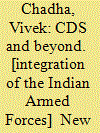

|
|
|
|
|
| Publication |
New Delhi, KW Publishers Pvt Ltd, 2021.
|
| Description |
viii, 174p.hbk
|
| Standard Number |
9788195285846
|
|
|
|
|
|
|
|
|
|
|
|
Copies: C:2/I:0,R:0,Q:0
Circulation
| Accession# | Call# | Current Location | Status | Policy | Location |
| 060029 | 355.033054/CHA 060029 | Main | On Shelf | General | |
| 060030 | 355.033054/CHA 060030 | Main | On Shelf | General | |
|
|
|
|
| 2 |
ID:
090450
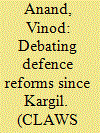

|
|
|
|
|
| Publication |
2009.
|
| Summary/Abstract |
In the light of the foregoing, it can be said that while a number of recommendations of the KRC report and GoM's report have been implemented, some of the key recommendations which would have improved joint ness and integration amongst the armed forces remain to be implemented in a meaningful manner.
|
|
|
|
|
|
|
|
|
|
|
|
|
|
|
|
| 3 |
ID:
157737


|
|
|
|
|
| Publication |
New Delhi, Pentagon Press, 2018.
|
| Description |
xii, 248p.hbk
|
| Standard Number |
9789386618344
|
|
|
|
|
|
|
|
|
|
|
|
Copies: C:2/I:0,R:0,Q:0
Circulation
| Accession# | Call# | Current Location | Status | Policy | Location |
| 059320 | 355.03/KAN 059320 | Main | On Shelf | General | |
| 059321 | 355.03/KAN 059321 | Main | On Shelf | General | |
|
|
|
|
| 4 |
ID:
164125
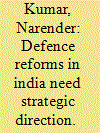

|
|
|
|
|
| Summary/Abstract |
Is there a clarity about what exactly is required from the Armed Forces in a changing regional and global security environment when national interests are spread across the continent? Big question is that, have we developed capabilities to secure India’s interests that are so varied and dispersed strategically and geographically? If India has to break out of the claustrophobic confines of South Asia, it needs certain capabilities that can propel it to be a net security provider at least in Northern Indian Ocean Region.1 However, the defence reforms or absence of these tells a different story; that India may desire to be there but the capabilities are not commensurate with the desired mandate. The Government of India has appointed the Defence Planning Committee (DPC) that would be a permanent body mandated to prepare a draft national security strategy, undertake a strategic defence review, and formulate an international defence engagement strategy.2 It will be premature to pass the judgement on DPC but a doubt remains that is it duplication and add-on to the existing cumbersome national security structure? Appointment of DPC should not be confused with the defence reforms as these are two different aspects.
|
|
|
|
|
|
|
|
|
|
|
|
|
|
|
|
| 5 |
ID:
102838


|
|
|
|
|
| Publication |
2011.
|
| Summary/Abstract |
This article examines the sweeping military reforms of Russian Defense Minister Anatolii Serdyukov and the future outlook for the Russian Armed Forces. Anatolii Serdyukov has had a meteoric rise from obscurity. His background in business and career in the Federal Tax Service made his appointment as Defense Minister extremely unlikely and many commentators speculated that his tenure would be short. Serdyukov has been proving his detractors wrong and is rapidly transforming the Russian Armed Forces, by many accounts enacting the most radical reforms in 100 years.
|
|
|
|
|
|
|
|
|
|
|
|
|
|
|
|
| 6 |
ID:
182875
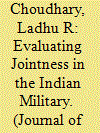

|
|
|
|
|
| Summary/Abstract |
The institutionalisation of jointness in the Indian military is a key driver of ongoing defence reforms. To attain this goal, the Indian Armed Forces are encapsulating principles of joint warfare, inhabiting joint capabilities and inculcating joint culture. However, the pace and process of jointness in the Indian military has been contentious since Independence. This article seeks to evaluate the state and nature of jointness in the Indian military by employing Jackson’s conceptual and methodological model for joint military activities.
|
|
|
|
|
|
|
|
|
|
|
|
|
|
|
|
| 7 |
ID:
103810


|
|
|
|
|
| Publication |
New Delhi, IDSA, 2011.
|
| Description |
63p.
|
| Series |
IDSA occasional paper no. 18
|
| Standard Number |
9798186019886
|
|
|
|
|
|
|
|
|
|
|
|
Copies: C:2/I:0,R:0,Q:0
Circulation
| Accession# | Call# | Current Location | Status | Policy | Location |
| 055882 | 355.0330954/MUK 055882 | Main | On Shelf | General | |
| 055883 | 355.0330954/MUK 055883 | Main | On Shelf | General | |
|
|
|
|
| 8 |
ID:
151423
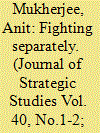

|
|
|
|
|
| Summary/Abstract |
How do countries transition from single service to joint operations? This article engages with the discussion on military innovation to argue that civil–military relations are the most important driver for jointness. In doing so it examines jointness in the Indian military. Relying on archival research and primary interviews this article sheds new light on the operations of the Indian Peacekeeping Forces (IPKF) in Sri Lanka from 1987–1990, the 1999 Kargil War and the Post-Kargil defence reforms. The main argument is that the Indian military’s transition to jointness has been ‘incomplete’ primarily because of its prevailing model of civil-military relations. This model prevents civilians from interfering in the operational issues of the military, including on matters pertaining to jointness. It therefore recommends more forceful civilian intervention to overcome the prevailing single service approach.
|
|
|
|
|
|
|
|
|
|
|
|
|
|
|
|
| 9 |
ID:
130407


|
|
|
|
|
| Publication |
2014.
|
| Summary/Abstract |
Budgetary pressures have driven a steady expansion of armaments collaboration projects internationally. This has also been the case in Europe where it is estimated that currently one-fifth of European procurement budgets are spent on collaborative weapons systems and the European Defence Agency has the long-term objective of increasing this figure by over 50%. The purpose of this article is to assess whether collaborative armaments projects can offer the benefits frequently attributed to them. To this end, the study examines the five combat aircraft projects that European states have collaboratively undertaken since the 1950s.
|
|
|
|
|
|
|
|
|
|
|
|
|
|
|
|
| 10 |
ID:
109811


|
|
|
| 11 |
ID:
130127
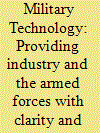

|
|
|
|
|
| Publication |
2013.
|
| Summary/Abstract |
2012 was not only great for Britain in celebrating the Queen's Diamond Jubilee and delivering unprecedented national sporting success, but also in laying the groundwork for substantial reform of the way defence is delivered
So now is an exciting time to be involved in the British Defence industry; a future of reform is coupled with our reinforced ambition to consolidate our position as a leading player in the global defence market.
It has been nearly four years since the now Chief of Defence Materiel Bernard Gray released his report on UK Defence acquisition. Since then we have made considerable progress in the way we think about procurement by not only fixing problems in the current system but by also putting in place models to minimise recurrence in future.
|
|
|
|
|
|
|
|
|
|
|
|
|
|
|
|
| 12 |
ID:
130860
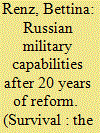

|
|
|
|
|
| Publication |
2014.
|
| Summary/Abstract |
Despite widespread perceptions, Russia is close to having the military it needs. In the aftermath of the Cold War, the leaders of the Russian Federation faced the unenviable task of creating national armed forces using what was left of the Soviet military. Plans to provide 'traditional' defence and to meet future challenges were considered as early as 1992, leading to a string of reform programmes over the next two decades. Such efforts were closely observed by analysts in the West and Russia, who documented the drawn-out process in a large body of literature. The assessments provided in the bulk of these works were almost unanimous: the reforms had failed, leaving the Russian armed forces 'impoverished, demoralized and largely ineffective', 'woefully inadequate to address the country's security threats' and standing 'perilously close to ruin'.
During the presidency of Boris Yeltsin, the reforms were seen as botched jobs that merely reduced troop numbers, essentially leaving Russia with a smaller version of a Soviet-style, mass-conscription army. The latest push for change, announced in the wake of the country's 2008 war with Georgia, during which the performance of the Russian military was widely criticised, met with a warmer reception, at least initially. It envisaged a comprehensive shift away from low-tech to high-tech; from conscription to professionalism; and from mass to mobility. Some structural changes, such as the transition from divisions to brigades and the streamlining of central command, were executed with impressive speed, raising expectations that Russia was finally on its way to acquiring a 'modern' military. As time went on, however, observers noted a range of problems that, in their eyes, dampened the prospect of ultimate success. The Russian defence industry remained unable to produce advanced equipment. The possibility of ending conscription and moving towards an all-volunteer force seemed to be as remote as ever. Moreover, the 2010 military doctrine continued to emphasise mobilisation, instead of focusing on permanent readiness and rapid reaction. When Defence Minister Anatoly Serdyukov was replaced by Sergei Shoigu - a long-standing ally of Russian President Vladimir Putin - in November 2012, some experts argued that the 2008 reforms were in effect 'dead'.
|
|
|
|
|
|
|
|
|
|
|
|
|
|
|
|
|
|
|
|
|